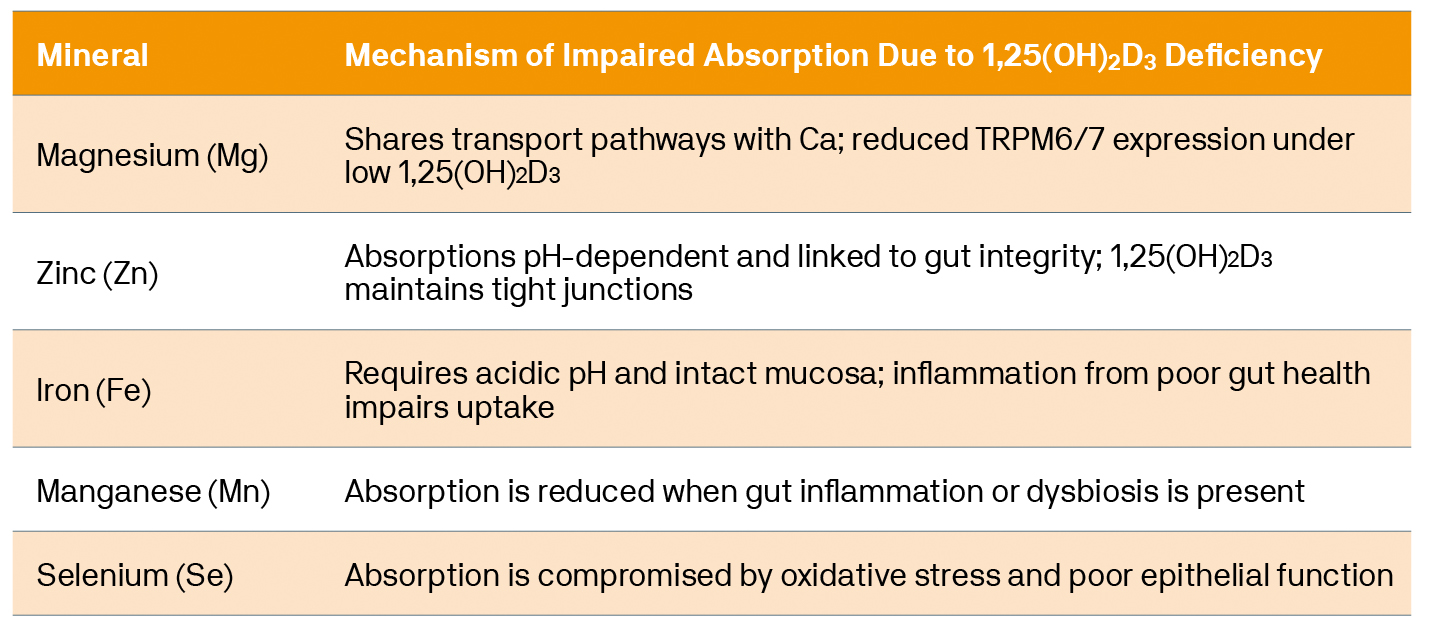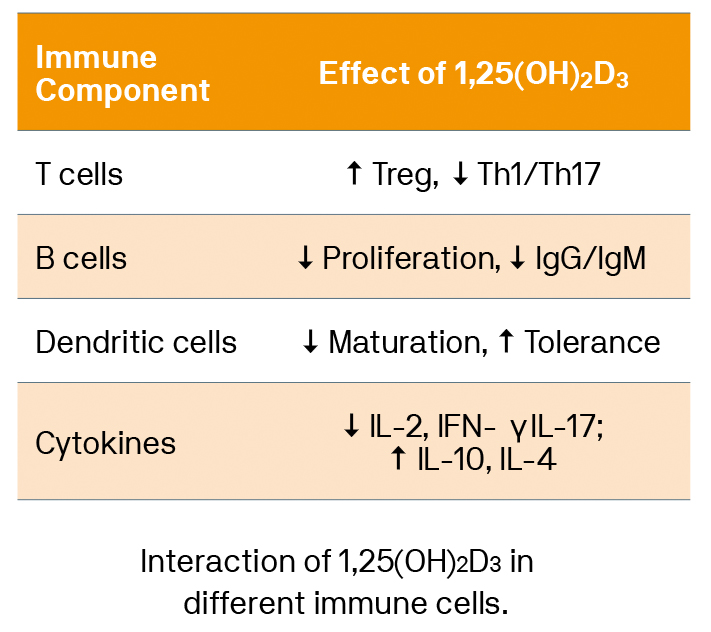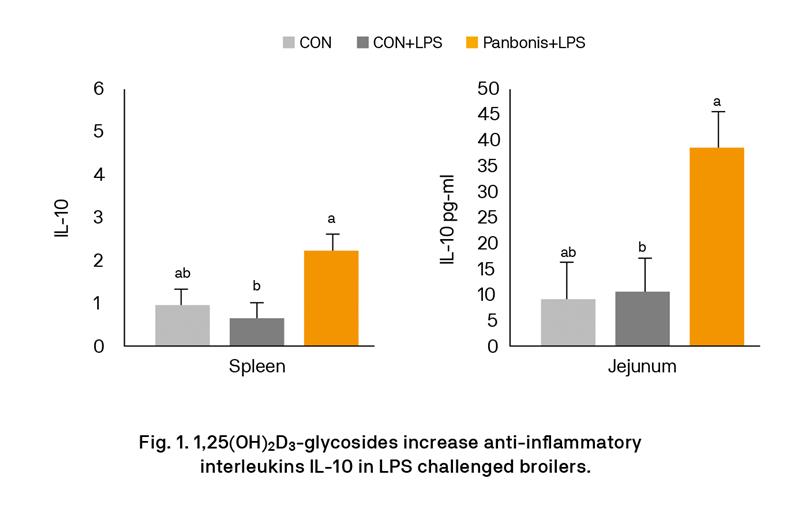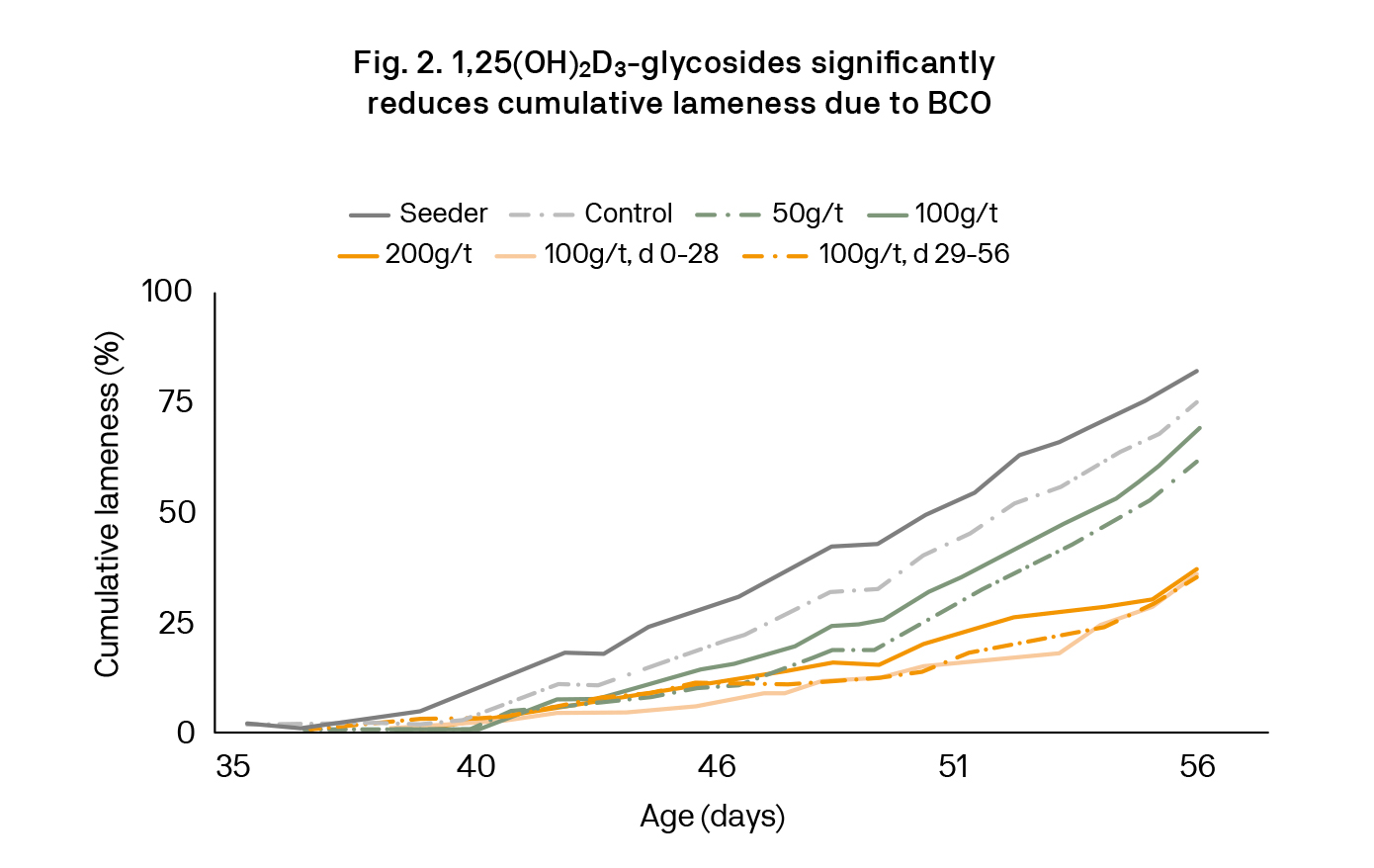


1,25-dihydroxycholecalciferol (1,25(OH)₂D₃), the active form of vitamin D, plays a vital role in calcium and phosphorus metabolism, skeletal health, immune regulation, muscle growth and a variety of other functions.
In poultry, particularly broilers with their impressive growth rate, supplementation with a special form of 1,25(OH)₂D₃ has gained attention due to its broad effects on performance, gut health, immunity, and disease resistance — especially against conditions like bacterial chondronecrosis with osteomyelitis (BCO), a major cause of lameness.
Gut health in broilers is essential for nutrient absorption, growth, and disease resistance. Optimal nutrient absorption is not only crucial for the ‘classic’ nutrients such as energy or proteins but it is also important for maximal efficiency of mineral absorption. Given adequate dietary mineral content, this prevents excess (= unabsorbed) calcium and phosphorus from binding with other nutrients in the intestinal lumen and thus rendering them indigestible.
Calcium and phosphorus are among the least efficiently absorbed nutrients in poultry.
While Ca and P are the most directly regulated by 1,25(OH)₂D₃, the following minerals can also be impacted:

Immunity
Nutrient and mineral absorption is also impaired by oxidative stress and inflammation. Dietary supplementation of 1,25(OH)₂D₃-glycosides supports gut health by enhancing tight junction integrity, reducing gut/tissue permeability, modulating the microbiota and preventing leaky gut.
The interaction between 1,25(OH)₂D₃ and gut health is extremely important and interlinked with innate and adaptive immunity. 1,25(OH)₂D₃ binds to the vitamin D receptor (VDR), which is expressed in the intestinal epithelial cells, and various immune cells in the gut (e.g. intraepithelial lymphocytes, T- and B-cells present in the lamina propria, dendritic cells and macrophages). This interaction modulates gene transcription, influencing both immune tolerance and barrier function by promoting among others the expression of antimicrobial peptides such as cathelicidins and β-defensins. These substances help control pathogens present/invading in the gut and bloodstream. Furthermore, 1,25(OH)₂D₃ upregulates tight junction proteins (e.g. occludin, claudins, ZO-1), thus reducing epithelial permeability. This prevents bacterial translocation and endotoxin leakage from the gut into the lumen or even the circulation. In this way, it promotes mucosal homeostasis and reduces the risk of chronic inflammation, one of the most frequent problems in modern poultry production.
Interaction of 1,25(OH)2D3 in different immune cells

What is the mechanism?
Modulation of Adaptive Immunity
In the gut, 1,25(OH)₂D₃ promotes regulatory T cell (Treg) differentiation. This differentiation is important for the body to recognise its own cells and non-dangerous substances and thus to avoid to start an immune reaction where it is not necessary. Misregulation of these Treg-cells is for example part of allergies or autoimmune disease. Another action is the suppression of the so called Th1 and Th17 response. These cells are also called T-helper cells and are involved in cell-based immunity and inflammation. By modulation TH1 and Th17 response, secretion of the pro-inflammatory cytokines IL-2, IFN-γ, and IL-17 is reduced. On the other side, it modulates Th2 cells (another group of T-helper cells) to a more tolerant response and enhances expression of IL-10, an anti-inflammatory cytokine.
This immunological shift leads to an overall immune modulation by a more targeted inflammatory reaction and increased immune tolerance—a state where the immune system recognizes feed antigens as harmless and avoids unnecessary inflammation.
This balance is crucial for preventing immune overactivation in the gut mucosa, dysbiosis and consequently uncontrolled, chronic inflammation!
Bacterial Chondronecrosis with Osteomyelitis (BCO)
BCO is a common leg disorder in fast-growing broilers, characterized by bacterial infection in the growth plate cartilage, leading to necrosis and osteomyelitis. Staphylococcus aureus and Enterococcus are the most frequent causative agent. Poor gut integrity and systemic inflammation increase the risk of bacterial translocation and subsequent infection in bones.
By improving gut barrier function and reducing systemic inflammation, 1,25(OH)₂D₃ lowers the likelihood of bacterial passage into the bloodstream. Additionally, its role in calcium and phosphorus metabolism enhances bone mineralization, which strengthens skeletal structure and reduces microfractures where bacteria can colonize. Experimental studies done at the University of Arkansas, USA, suggest that dietary supplementation with 1,25(OH)₂D₃ reduces BCO incidence, improves bone integrity, and supports locomotor health in broilers.
Panbonis®, a plant-based feed material which contains glycosylated 1,25-dihydroxycholecalciferol, supports the vitamin D and calcium and phosphorus homeostasis. It has additionally been shown to increase anti-inflammatory cytokines IL-10 in jejunum and spleen in LPS challenged broilers (Figure 1) and has shown a potent epithelium barrier function against the entry of bacteria typical responsible for BCO. The supplementation of Panbonis® during the first 3 weeks of life (Figure 2) is enough to strengthen bone mineralization and increases the birds immunity until slaughter.
vitamin D and calcium and phosphorus homeostasis. It has additionally been shown to increase anti-inflammatory cytokines IL-10 in jejunum and spleen in LPS challenged broilers (Figure 1) and has shown a potent epithelium barrier function against the entry of bacteria typical responsible for BCO. The supplementation of Panbonis® during the first 3 weeks of life (Figure 2) is enough to strengthen bone mineralization and increases the birds immunity until slaughter.
Figure 1. 1,25(OH)2D3-glycosides increase anti-inflammatory interleukins IL-10 in LPS challenged broilers

Figure 2. 1,25(OH)2D3-glycosides significantly reduces cumulative lameness due to BCO

Conclusion
A natural source of 1,25(OH)₂D₃ as glycoside is a potent nutritional and immunological regulator in broilers. Its supplementation can improve gut integrity, modulate immune responses, and significantly reduce the risk of BCO. With the ongoing target to reduce the use of antimicrobials in poultry production, targeted use of bioactive compounds like 1,25(OH)₂D₃ – glycosides offer a promising alternative to enhance bird health, welfare, and performance.
References available from the authors upon request














